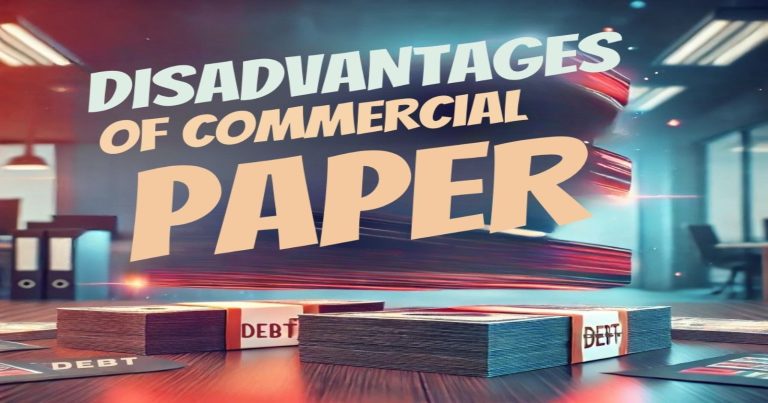Commercial Paper use is restricted to financially robust firms, making it an inaccessible option for many small or unstable companies which becomes the disadvantage of commercial paper. Commercial paper is a short-term debt instrument issued by corporations, is a popular means of raising funds for immediate financial needs. Despite its utility, businesses should understand the disadvantages of commercial paper before incorporating it into their financial strategies. Other limitations include limited flexibility, market fluctuations, and repayment risks, which can significantly affect both issuers and investors. Factors like limited issuer eligibility, market fluctuations, and regulatory challenges make commercial paper a financing tool suited only for specific circumstances. In this article, we delve deep into the nuances of commercial paper, its benefits, and its significant drawbacks, offering a comprehensive guide for businesses and investors alike.
Meaning of Commercial Paper
Commercial paper is an unsecured short-term promissory note issued by companies to meet their working capital needs. It serves as a substitute for bank loans and has a maturity period that usually ranges from 7 to 270 days. Commercial papers are only issued by companies with good credit ratings so that the risks for investors are kept at bay.
Key Features
- Unsecured Nature: It is based on the issuer’s creditworthiness rather than collateral.
- Short Maturity: Best suited to fill short-term financial gaps.
- Negotiable Instrument: This can be easily transferred in the money market.
Who Can Issue Commercial Paper?
Commercial paper can be issued only by large, reputable corporations. Such a restriction limits the safety of the instrument to investors but cuts out many of the smaller operations.
Eligibility Criteria
- Only firms have a high rating from well-known rating agencies.
- Regulators have stipulated a minimum level of tangible net worth.
Issuers
- Banks and other financial institutions.
- Corporates with strong financial positions.
- Subsidiaries of multinational corporations.
Regulatory Constraints
- Issuers must comply with central bank guidelines.
- Limitations on the maximum amount based on company net worth.
Advantages of Commercial Paper
The advantages of commercial paper are the reasons for its popularity. In discussing the disadvantages, it is important to understand why large corporations prefer it.
- Cost-Effective: It has a lower interest rate than bank loans.
- Flexibility: The terms, such as maturity periods, can be customized according to the needs of the issuers.
- Access to Market: It raises funds without affecting the ownership.
- Liquidity: Commercial papers are very liquid instruments since they are negotiable.
How Do People Invest in Commercial Paper?
Commercial paper investments are usually very safe since it is an instrument of the paper issuer’s credit. However, the investments are not available directly for the individual investor.
Investment Platforms:
- Via money market mutual funds.
- Direct purchase through brokers for high net worth individuals.
Risks:
- Credit risk because of the potential financial instability of the issuer.
- Liquidity risk if the secondary market is thin.
- Central banks regulate the commercial paper market to ensure investor protection.
Disadvantages of Commercial Paper
While commercial paper provides several benefits, it also has several drawbacks. These disadvantages of commercial paper can have a huge impact on both issuers and investors, making it less practical in some situations. Here is a detailed discussion of each disadvantage.
Accessibility
- Credit ratings agencies check and authenticate the soundness of a company’s financial situation before the permission to issue commercial paper is granted. This has ensured that the risk, though smaller, is not zero for investors and prevents its wider usage.
- Most SMEs, which usually have no established credit ratings and there is a lack of considerably stronger financial strength, cannot take advantage of this financing tool.
Market Dependency
- When market confidence is low, the investors may fear to invest in unsecured papers like commercial paper and instead, go for other safer investments. In such scenarios, companies have to pay high borrowing costs to attract buyers.
- Also, at low subscription levels, issuers would have to approach other sources for funding. So, this will make commercial paper a less efficient tool during the economic uncertainty and market volatility period.
Short-Term Nature
- Most commercial papers have a maturity period of between 7 and 270 days. For companies using this tool to maintain liquidity, the constant refinancing required becomes a risk.
- When market conditions change or when the company’s financial health declines, refinancing may become costly or unavailable.
No Collateral
- Being an unsecured instrument, commercial paper relies entirely on the credit rating of the issuer. A decline in financial stability can expose the issuer to risks of default.
- Since this kind of commercial paper does not need collateral, the repayment assurance lies on the issuer’s capacity to maintain a strong credit profile.
- Business companies that are caught unaware of unexpected financial distress or adverse market events can find it difficult to perform their obligation.
Interest Rate Sensitivity
- Interest rates for commercial paper are market-driven, which makes them highly susceptible to fluctuations. This can make the borrowing costs unpredictable.
- Falling interest rates may help issuers but may discourage investors who seek higher returns.
- This volatility creates uncertainty for both parties, making commercial paper less attractive in unstable economic periods.
High-Risk for Investors
- Investors in commercial paper face significant credit risk, especially if the issuer’s financial condition worsens.
- Unlike secured debt instruments, commercial paper does not provide any protection to investors in case of default.
- If the credit rating of the issuer deteriorates or if there is financial instability, investors will be exposed to heavy losses.
Regulatory Constraints
- The issuance of commercial paper is subject to strict regulatory conditions, thereby restricting flexibility for potential issuers.
- Regulators impose strict guidelines to ensure the safety and stability of the commercial paper market.
- For example, small companies or those with complex financial structures might find it challenging to meet these standards, deterring them from utilizing this tool.
Disadvantages of Commercial FAQs
What is the main drawback of commercial paper?
Its main drawback is limited accessibility since only large, creditworthy corporations can issue it.
Can individuals directly invest in commercial paper?
No, most people do so indirectly via mutual funds or brokers.
What impact does market dependency have on commercial paper?
The issue of commercial paper is strongly dependent on market conditions and is therefore vulnerable to all economic swings.
Why is the secondary market for commercial paper less liquid?
There are fewer buyers, and demand in the secondary market is limited as well, hence it is not as liquid as other instruments.
What are the risks for investors in commercial paper?
Investors face credit and liquidity risks, especially if the issuer’s financial condition weakens.


